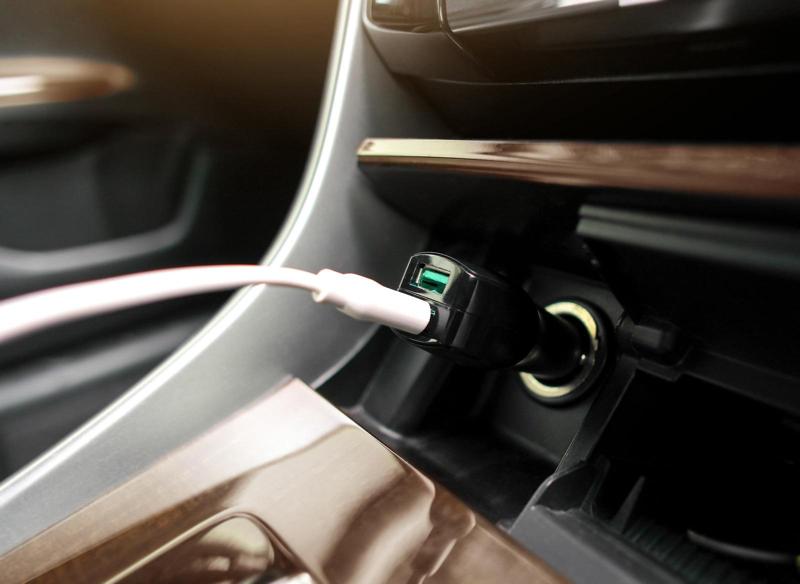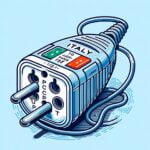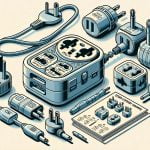Planning a trip to Italy? One important thing you’ll need to consider is the type of power converter you’ll need for your electronic devices.
Italy uses a different voltage and outlet configuration compared to North America, making it essential to have the right power converter to avoid damaging your electronics. In this article, we’ll explore the importance of power converters for travel to Italy, understand the voltage and outlets in Italy, explore different types of power converters, find the right converter for your specific electronics, use them safely while in Italy, and consider alternatives for charging devices.
When traveling from North America to Italy, one of the most important things to keep in mind is the difference in voltage and outlet standards. Italy operates on 230 volts and uses a unique type of power outlet that differs from North American standards. Plugging in devices designed for 120 volts into 230-volt outlets without a proper converter can lead to irreparable damage. This is why it’s crucial to have the right power converter when traveling to Italy.
To ensure you have the right power converter for your trip to Italy, it’s essential to understand the standard voltage and outlet types in the country. By familiarizing yourself with these differences and knowing what type of converter you need, you can safeguard your electronic devices from potential damage. Additionally, understanding these technical aspects will allow you to make an informed decision when choosing a power converter that suits your specific needs.
Understanding the Voltage and Outlets in Italy
Italy has a unique electrical system with its own voltage and outlet standards, which can differ significantly from those in North America. In Italy, the standard voltage is 230 V and the frequency is 50 Hz, while the power outlets typically feature plugs with three round pins in a row. This stark contrast to the 120V and 60Hz system used in North America highlights the crucial need for power converters when traveling to Italy.
For North American travelers visiting Italy, it is essential to understand these differences and take the necessary precautions to avoid damaging their electronic devices. Using a power converter specifically designed for Italy’s electrical specifications can ensure that your devices receive the correct voltage and frequency, preventing potential harm or malfunction.
It’s important to note that while some electronic devices are equipped with universal power adapters that support various voltages and frequencies, not all products offer this feature. Therefore, it’s crucial to research and identify which devices require a power converter before traveling to Italy. Investing in the right power converter will safeguard your electronics and provide peace of mind during your trip.
| Italy | North America |
|---|---|
| Voltage: 230V | Voltage: 120V |
| Frequency: 50Hz | Frequency: 60Hz |
| Power Outlets: Three round pins in a row | Power Outlets: Two flat parallel pins or two parallel flat pins with a ground pin |
Types of Power Converters for Travel to Italy
When traveling to Italy, it is crucial to have the right power converter to ensure that your electronic devices can function properly. Italy operates on a 230-volt system, which is different from the standard 120-volt system in North America. Additionally, the outlet types in Italy are also different, with Type L outlets being the most common. Having the right power converter is essential to avoid damaging your electronics and ensuring they can be used safely.
There are several types of power converters available for travelers heading to Italy. Here are some options to consider:
- Voltage Converters: These converters are designed to step down the voltage from 230 volts to 120 volts, allowing North American devices to be used safely in Italy.
- Plug Adapters: While not technically converters, plug adapters are necessary for physically connecting North American plugs to Italian outlets. Make sure to choose an adapter that is compatible with Type L outlets.
- All-in-One Converters: These versatile converters can handle both voltage conversion and plug adaptation in one device, making them convenient for various electronics.
It’s important to choose the right power converter for your specific needs and devices. Some converters may be better suited for smaller electronics like smartphones and cameras, while larger appliances may require a more robust converter. Always check the wattage requirements of your devices and select a converter that can handle the necessary power output.
By understanding the types of power converters available and selecting the appropriate one for your needs, you can ensure that your electronic devices will work safely and effectively during your travels in Italy. Researching and investing in the right converter will provide peace of mind and convenience while exploring all that Italy has to offer.
Finding the Right Power Converter for Your Electronics
Italy, like most of Europe, operates on a 230-volt system, which is different from the standard 120 volts used in North America. This means that North American electronics will not be compatible with Italian power outlets without the use of a power converter. Using electronic devices without the proper converter can lead to damage to the device and pose safety risks.
There are two main types of power converters that are commonly used for travel to Italy: voltage converters and plug adapters. A voltage converter is necessary when you need to convert the actual voltage of the electricity, while a plug adapter is needed when you simply need to adapt the shape of the plug to fit into a foreign outlet.
It’s important to determine which type of converter you need based on your specific electronic devices and their voltage requirements.
When choosing a power converter for your electronics, it is essential to consider the voltage and wattage requirements of each device. Most modern devices come with built-in compatibility for different voltages, but it’s crucial to check before plugging them into an electrical outlet in Italy. Additionally, some devices may have higher wattage requirements, such as hair dryers or kitchen appliances, which may require a higher wattage power converter.
| Power Converter Type | Best For |
|---|---|
| Voltage Converter | Devices that are not dual-voltage compatible (e.g., laptop chargers) |
| Plug Adapter | Devices with compatible dual-voltage (e.g., smartphones) |
Overall, finding the right power converter for your electronics involves understanding the specific needs of each device and ensuring that they are properly matched with a suitable converter. Not only does this prevent damage to your electronics while traveling in Italy, but it also provides peace of mind knowing that you can safely use your devices abroad.
Using Power Converters Safely in Italy
Understanding Italian Electrical Standards
In Italy, the standard voltage is 230 V and the frequency is 50 Hz. This can vary across different regions, so it’s important to check the specifics of your travel destination. Additionally, the outlet type in Italy is the Type F socket, which has two round pins. This is different from the Type A or Type B sockets commonly found in North America.
Tips for Using Power Converters Safely
When using a power converter in Italy, it’s crucial to follow some safety guidelines to avoid damaging your devices or encountering electrical issues. Firstly, make sure to use a high-quality converter that can handle the voltage and wattage requirements of your electronics. It’s also recommended to unplug your devices when not in use to prevent overheating or potential hazards.
Avoid Overloading Converters and Outlets
One common mistake when using power converters is overloading them with multiple devices plugged in at once. It’s essential to check the power ratings of your converter and ensure that you are not exceeding its capacity. Similarly, be mindful of overloading the Italian outlets, as they may not be designed to handle too much electrical load at once. Consider using a multi-outlet power strip with surge protection for added safety and convenience.
Top Picks for Power Converters for Travel to Italy
Reviews of Top-Rated Power Converters
When it comes to choosing the right power converter for travel to Italy, there are a variety of options available on the market. Some popular choices include the Ceptics USA to Italy Travel Adapter Plug, BESTEK Universal Travel Adapter, and Foval International Travel Adapter. These converters are designed to work with the voltage and outlet standards in Italy, ensuring that your electronic devices can be safely powered without risk of damage.
Considerations for Size, Weight, and Versatility
When selecting a power converter for travel to Italy, it’s important to consider factors such as size, weight, and versatility. Depending on your travel needs, you may want a compact converter that is easy to pack and transport. Additionally, some converters offer built-in USB ports or support for multiple devices, making them more versatile for charging various electronics while traveling.
Compatibility with Different Types of Electronics
Another important consideration when choosing a power converter for travel to Italy is ensuring compatibility with different types of electronics. This includes everything from smartphones and laptops to hairdryers and electric shavers. Look for a converter that offers sufficient wattage and voltage output to meet the needs of your specific devices. It’s also worth considering converters with surge protection features to safeguard against potential power fluctuations while abroad.
Alternatives to Power Converters for Traveling to Italy
While power converters are an essential item for travelers visiting Italy, there are alternative options for charging devices without the need for a converter. Here are some alternatives to consider:
- Portable Chargers: Portable chargers, also known as power banks, are a convenient option for keeping devices charged while on the go. These battery-powered devices can be charged in advance and then used to recharge smartphones, tablets, and other electronics without the need for a power converter.
- Battery Packs: Similar to portable chargers, battery packs provide a backup power source for electronic devices. These compact and lightweight packs can be easily carried in a purse or backpack, offering a convenient solution for charging devices without needing to plug into Italian outlets.
- USB Charging: Many electronics, including smartphones and tablets, can be charged directly through a USB connection. This means that travelers can use their device’s USB cable to charge directly from a computer or other USB-compatible device, eliminating the need for a power converter altogether.
By considering these alternative options, travelers can ensure that they have reliable methods for keeping their electronic devices charged while in Italy without the need for a traditional power converter. It’s important to research and plan ahead to determine which alternative method is best suited for specific devices and travel needs.
Conclusion
In conclusion, having the right power converter is essential for a smooth and safe travel experience in Italy. Understanding the voltage and outlet differences between Italy and North America is crucial in order to avoid damaging your electronics. By choosing the appropriate power converter for your specific needs and devices, you can ensure that your electronics are protected and able to function properly while traveling in Italy.
It’s important to remember that using power converters safely is key to avoiding any mishaps or overloads. Being mindful of the wattage requirements of your electronics, as well as following safety tips for using power converters in a different country, will help you have a worry-free experience. Additionally, considering the size, weight, and versatility of the power converter while traveling can also contribute to a more convenient travel experience.
While power converters are essential for charging electronic devices in Italy, it’s also worth exploring alternative options such as portable chargers or battery packs. These alternatives can provide added convenience and backup charging options while on the go. Ultimately, with the right power converter and potentially some backup charging solutions, travelers can ensure that their electronic devices remain powered up throughout their stay in Italy, allowing them to fully enjoy their trip without any technological hiccups.

I’m a passionate traveler, writer, and Italophile. My fascination with Italy’s history, art, and culture has led me on countless adventures across the Italian landscape. Through “I Live Italy,” I share my love for this extraordinary country and aims to inspire others to explore its boundless beauty.





